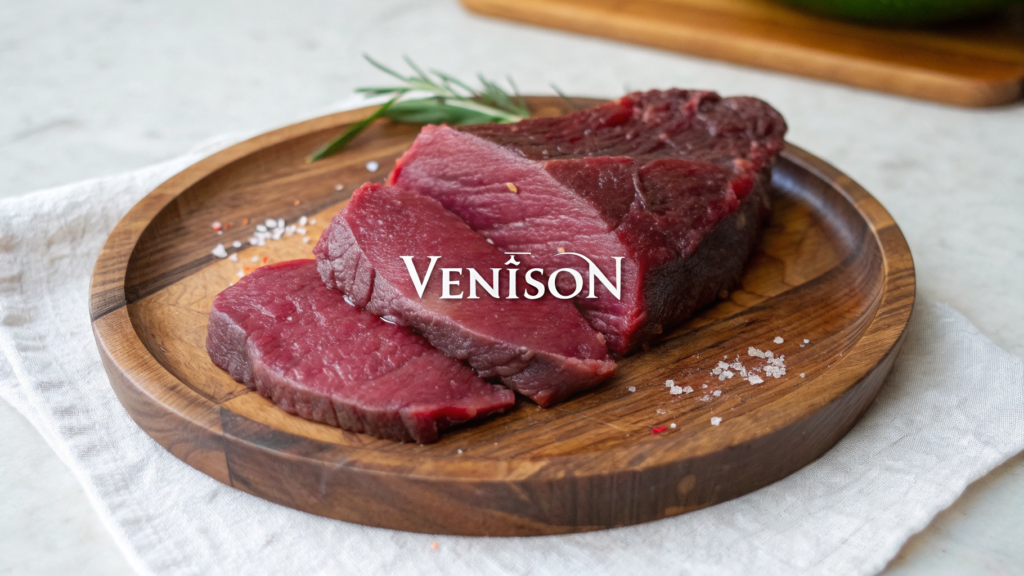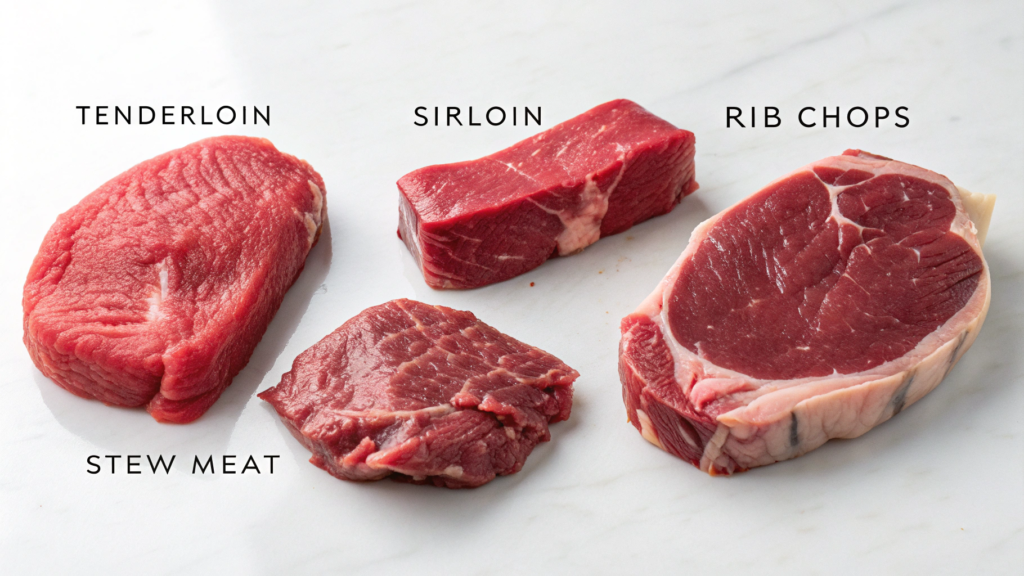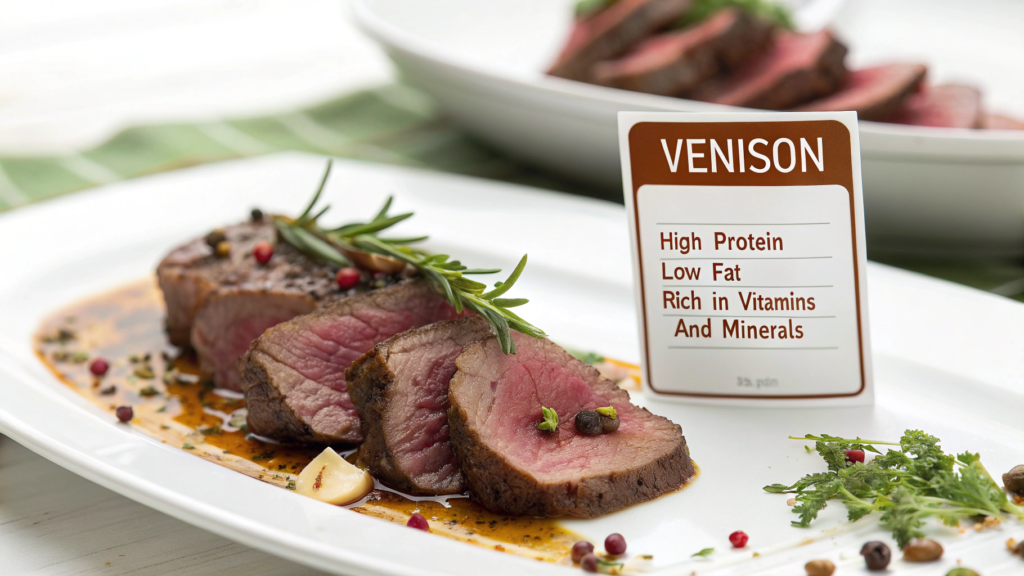What is Venison? A Comprehensive Guide to This Unique Meat

Venison, often called the hidden gem of meats, is a delicacy loved by many for its unique taste and versatility. But what exactly is venison, and why is it gaining popularity in kitchens worldwide? This article dives deep into the world of venison, exploring its history, various cuts, nutritional benefits, and how best to prepare it. You’ll learn everything from the basic definition of venison to tips for cooking it like a pro. Whether you’re a seasoned foodie or just curious about trying something new, this guide will cover all you need to know. By the end, you’ll see why venison deserves a spot on your plate. Let’s start this journey together!
Introduction to Venison
learn more about Venison in WIKIPEDIA
What is Venison?
Venison refers to meat sourced primarily from deer, though in some regions, it may include elk, moose, or antelope. Unlike beef or pork, venison is a wild game meat, meaning it comes from animals hunted in their natural habitats. This gives it a distinct flavor that many describe as earthy or slightly sweet. Venison is incredibly lean, with little fat compared to other meats, which makes it a healthy protein choice. Its unique texture and taste set it apart from the meats you’re used to.
If you want to master cooking venison to make it tender and flavorful, you might enjoy this guide: How to Make Venison Tender.
Another thing that makes venison special is its versatility. It can be turned into steaks, sausages, or even slow-cooked stews. The flavor varies depending on the animal’s diet and the cut of meat. For example, tenderloin offers a melt-in-your-mouth experience, while cuts like the shank are perfect for hearty recipes. Venison’s distinctive qualities make it an exciting choice for adventurous eaters.
Historical Context of Venison Consumption
The story of venison dates back thousands of years. Early humans relied on deer as a primary food source, hunting them for survival. In medieval Europe, venison became a symbol of wealth and privilege. Nobles and kings often feasted on this prized meat, while commoners rarely had the chance to taste it. Hunting was strictly regulated, making venison a luxury item.
In the Americas, indigenous tribes cherished deer meat for its nutritional value. They used every part of the animal, ensuring nothing went to waste. Today, venison still holds a place of cultural significance in many traditions, from Native American ceremonies to European culinary arts. This deep-rooted history is part of what makes venison so fascinating to explore.
Modern Popularity of Venison
Fast forward to today, and venison is making a big comeback. More people are looking for healthier, sustainable protein options, and venison fits the bill. With its low fat content and rich flavor, it’s becoming a favorite among chefs and home cooks alike. Hunting is also growing in popularity as a way to source local, ethical meat.
For a beginner-friendly recipe to try at home, explore this Perfect Venison Roast Recipe.
Many restaurants are including venison on their menus, offering dishes like venison burgers or roasted tenderloin. This is helping more people discover its appeal. Plus, with the rise of farm-raised deer, venison is becoming easier to access. If you’re ready to try something new, venison is a fantastic option to consider. It’s a delicious way to bring history, sustainability, and flavor to your table.
Types of Venison Cuts

Primary Cuts of Venison
Venison has several primary cuts, each offering unique flavors and uses. The backstrap is one of the most popular cuts. It’s a long, tender strip of meat taken from the spine, often compared to a beef filet. People love it for grilling or roasting. The tenderloin, nestled inside the ribcage, is even more delicate. Its mild flavor and melt-in-your-mouth texture make it perfect for a special meal.
Moving to the leg, this large cut is often divided into smaller sections. The top round, bottom round, and sirloin offer lean options ideal for roasting, grilling, or slicing into medallions. Shanks, located near the lower legs, are tougher but shine in slow-cooked dishes like stews. If you’re new to venison, starting with these primary cuts is smart. Each one brings something special to the table, making it fun to experiment with.
Specialty Cuts: Shank, Flank, and Neck
While less common, specialty cuts like the shank, flank, and neck are worth exploring. Shanks are packed with connective tissue, which melts beautifully during slow cooking. Think hearty stews or braised dishes—they’re ideal for cold nights. The flank is thin and lean, best when marinated and grilled quickly. Some folks even slice it for fajitas or jerky.
The neck is surprisingly versatile. It’s rich in collagen, making it perfect for slow-cooked meals or soups. It can also be shredded for tacos or curries. These cuts might take a little more effort to prepare, but they’re incredibly rewarding. With their bold flavors and unique textures, they’re excellent choices for adventurous cooks looking to try something new with venison.
Bones and Offal: Beyond the Basics
Venison isn’t just about steaks and roasts—it goes way beyond. Bones can be roasted and simmered to create flavorful stocks or soups. They add depth to any dish and reduce waste, making them eco-friendly. Don’t skip the offal, either. The liver, heart, and even tongue offer bold, rich flavors. Many chefs use these to create gourmet dishes like pâtés or tacos.
Heart is especially popular for its tender texture and mild taste. When marinated and grilled, it’s surprisingly delicious. Using every part of the deer isn’t just practical; it’s a way to honor the animal. So if you’re wondering, what is venison beyond the usual cuts? The answer is simple: it’s an adventure waiting to be explored.
Nutritional Value and Health Benefits of Venison

Venison is more than just delicious—it’s also incredibly nutritious. If you’re interested in learning more about its health benefits, don’t miss the detailed guide: Is Venison Healthy?.
Lean Protein Source
If you’re after a healthy protein, venison is a fantastic choice. It’s incredibly lean, meaning it has very little fat compared to beef or pork. This makes it great for people watching their calories. Despite being lean, it’s packed with protein, giving your body the energy it needs. Many athletes and fitness enthusiasts choose venison because it’s nutritious and filling.
Venison’s low fat content also means it cooks differently. It’s best served medium-rare to keep it tender. Overcooking can make it tough. The next time you’re considering a healthy meat option, give venison a try. You’ll enjoy its rich flavor without the guilt of eating something fatty.
Rich in Vitamins and Minerals
Venison is more than just protein—it’s a powerhouse of vitamins and minerals. It’s especially high in iron, which helps keep your blood healthy. It’s also rich in B vitamins, like B12 and niacin, which support your energy levels. Plus, venison has zinc and phosphorus, which are great for bone health and immune support.
Because deer live in the wild, their meat is free from antibiotics or hormones, making it a natural choice. If you’re looking for a nutrient-packed alternative to store-bought meats, venison is hard to beat. It’s like getting a multivitamin in your meal! The best part? It’s delicious, too.
Venison vs. Other Meats
How does venison stack up against other meats? For starters, it’s leaner than beef, pork, or lamb, making it a healthier option. Venison is also lower in calories while delivering the same amount of protein. If you’re comparing flavor, venison’s earthy, slightly sweet taste stands out. It’s different but in a good way!
Unlike farmed meats, venison is usually free-range, giving it a cleaner, more natural quality. It’s also more sustainable, with a smaller environmental footprint. Choosing venison means enjoying great taste and doing something good for your health and the planet.
Cooking Venison: Tips and Techniques
Best Practices for Preparing Venison
Cooking venison can feel a bit tricky at first, but following a few tips makes it easy. Start by choosing the right cut for your recipe. For example, tender cuts like the backstrap are best for grilling or quick searing, while tougher cuts like shanks shine in slow-cooked meals. Always thaw venison gently in the fridge to preserve its texture and flavor.
Next, don’t forget to marinate! Venison’s lean nature benefits from added moisture. Marinades also reduce any gamey flavors, making the meat even more enjoyable. Avoid overcooking, as venison is best served medium-rare to medium. This keeps it juicy and tender. Using a meat thermometer helps get it just right. With a bit of practice, venison can become one of your favorite meats to cook. So, it’s an exciting challenge for your culinary skills
Popular Cooking Methods
Venison is incredibly versatile, working well with many cooking methods. Grilling is a popular choice, especially for tenderloin or backstrap. A hot grill locks in the juices, creating a smoky, charred flavor. Roasting is another excellent option for larger cuts, like the leg or shoulder. Adding root vegetables to the roasting pan creates a full, hearty meal.
For tougher cuts, braising is the way to go. Slow cooking in a flavorful liquid softens the meat beautifully. Stews and soups are great ways to enjoy these cuts. Don’t overlook smoking! Venison absorbs smoky flavors exceptionally well, making it perfect for jerky or smoked tenderloin. With so many ways to cook venison, there’s always something new to try.
Common Mistakes to Avoid
When cooking venison, there are a few mistakes to steer clear of. First, avoid overcooking. Venison is lean, so it can dry out quickly if cooked too long. Use a thermometer and aim for medium-rare. Next, don’t skip resting the meat after cooking. Allowing it to rest for a few minutes keeps the juices inside.
Another mistake is not trimming the silver skin, a tough, chewy membrane that doesn’t break down during cooking. Removing it improves both texture and flavor. Finally, don’t drown venison in heavy sauces or bacon. While adding fat can help, too much hides the meat’s natural flavor. By avoiding these pitfalls, you’ll get the best results every time you cook venison.
Sustainability and Ethical Considerations
Ethical Hunting and Venison Production
Sustainability and ethics are essential when it comes to venison. Wild venison often comes from animals hunted under strict regulations. These rules ensure populations remain balanced and ecosystems stay healthy. Ethical hunters use every part of the deer, reducing waste and respecting the animal’s life.
Farm-raised venison is another ethical option. Deer are raised in open spaces and fed natural diets, avoiding the crowded conditions of industrial farming. This makes venison a sustainable and humane choice. Choosing venison means supporting responsible practices, whether it’s wild or farm-raised. By enjoying venison, you’re not just treating yourself—you’re helping the environment too.
Environmental Benefits of Venison
Venison is a greener meat option for many reasons. First, wild deer don’t require the resources needed for livestock farming, like water or feed. This makes venison an eco-friendly alternative. Farmed venison is also more sustainable than beef or pork, as deer farming has a smaller environmental impact.
Choosing venison reduces your carbon footprint while supporting biodiversity. Many areas manage deer populations to prevent overgrazing, which can harm other wildlife. By eating venison, you’re contributing to conservation efforts. Plus, the meat is free from hormones or antibiotics, making it a natural and healthy choice.
Frequently Asked Questions About Venison
What Does Venison Taste Like?
Venison has a rich, earthy flavor that’s different from beef or pork. Some describe it as slightly sweet or nutty. The taste depends on the deer’s diet. For example, deer that graze on wild plants or berries often have a milder flavor. Others, especially those from farmland areas, may taste slightly stronger.
If you’re worried about gamey flavors, don’t be. Proper preparation, like marinating or pairing venison with the right spices, minimizes it. The key is not to overcook it. Venison cooked medium-rare retains its natural tenderness and flavor. Many people find venison a delicious and unique alternative to traditional meats. Once you try it, you’ll likely find yourself wondering,
Is Venison Healthier Than Beef?
Yes, venison is a healthier choice compared to beef. It’s much leaner, containing far less fat. This makes it a great option for anyone trying to reduce their calorie intake. Despite being lean, venison is packed with protein, giving your muscles the fuel they need.
It’s also rich in essential nutrients like iron and B vitamins, which help keep your body energized. Another advantage is that venison is often free from antibiotics and hormones, making it a cleaner, more natural option. If you’re looking for a meat that’s nutritious, delicious, and guilt-free, venison is hard to beat.
Can Venison Be Cooked Medium-Rare?
Absolutely! Venison is best enjoyed medium-rare. Cooking it this way keeps the meat tender and juicy. Overcooking venison can make it tough and dry due to its low fat content. To get it just right, use a meat thermometer and aim for an internal temperature of 130–135°F.
Resting the meat after cooking is also important. This helps the juices redistribute, keeping every bite flavorful. Whether you’re grilling, roasting, or pan-searing, medium-rare venison is a surefire way to impress your taste buds.
What Are the Best Marinades for Venison?
Marinating venison enhances its flavor and helps tenderize the meat. The best marinades include ingredients like red wine, garlic, rosemary, or soy sauce. For a sweeter touch, you can use honey or brown sugar.
Citrus-based marinades with lemon or orange juice work well too, adding a refreshing twist. The secret is to let the venison soak for at least a few hours, or overnight if possible. Experiment with flavors you enjoy. With venison, the possibilities are endless!
How Long Can You Store Venison?
Venison lasts up to 3–5 days in the fridge if stored properly. Always wrap it tightly to prevent air exposure. For longer storage, freeze it. Frozen venison stays good for up to a year when vacuum-sealed.
When you’re ready to cook, thaw it slowly in the fridge. Avoid using the microwave, as it can affect the texture. Following these tips keeps your venison fresh and ready for any recipe.
is deer meat healthy ?
Deer meat, often called venison, is a great choice if you’re looking for something healthy and nutritious. First, it’s naturally lean, so it has less fat than beef or pork. It’s also packed with protein, which helps keep you full and supports muscle growth. In addition, it’s rich in essential nutrients like iron and zinc, which are good for your energy levels and immune system. Venison is low in calories, making it a fantastic option if you’re watching your diet. Plus, it’s wild and free from added hormones. With all these benefits, deer meat is a wholesome addition to any meal!
is venison healthy ?
Yes, venison is a healthy meat option you’ll want to try. It’s low in fat but high in protein, making it filling and nutritious. Also, venison contains important vitamins like B12, which helps keep your body energized. In addition, it’s packed with iron and zinc, essential for overall health. Venison is also a cleaner choice because it’s free from antibiotics and hormones. If you’re looking for a tasty yet healthy alternative to traditional meats, venison is a great pick. It’s delicious, easy to cook, and perfect for creating wholesome meals the whole family will love!
is venison good for you ?
Venison is definitely good for you and a fantastic alternative to more common meats. First, it’s low in saturated fats, which makes it heart-friendly. Then, it’s high in protein, helping you stay energized and satisfied. Venison is also a natural source of iron, which boosts your energy levels and supports healthy blood flow. Plus, it’s packed with zinc and B vitamins, all of which are essential for your overall well-being. What’s great is that venison is free of added chemicals, making it a cleaner choice. So, yes—venison is not just tasty but also incredibly good for you!
what does venison taste like ?
Venison has a unique flavor that’s rich, slightly sweet, and a bit earthy. First, it’s less fatty than beef, so the taste is leaner and more refined. Then, depending on the cut, it can be tender and juicy or hearty and robust. Some say it has a mild gamey note, which adds to its character. If you prepare it well, venison can be a flavorful and satisfying choice for any dish. With the right seasoning and cooking technique, it transforms into something truly special. Venison tastes like nature’s best, offering a delicious adventure for your taste buds!
Conclusion and Key Takeaways
Why Venison Is a Versatile and Sustainable Choice
Venison isn’t just delicious; it’s also incredibly versatile and sustainable. You can prepare it in countless ways, from grilling to slow cooking. It’s a lean, healthy protein that fits well into any diet. Plus, its natural, wild origins make it a more ethical and eco-friendly choice than factory-farmed meats.
Choosing venison supports responsible practices, whether it’s from ethical hunting or farm-raised sources. It also reduces your carbon footprint, making it a win for the environment. Venison’s unique flavor and nutritional benefits are just bonuses. If you haven’t tried it yet, there’s never been a better time to explore this remarkable meat.
Encouragement to Explore Venison in Your Diet
Now that you know the answer to what is venison, why not give it a try? It’s perfect for adventurous eaters and those looking for healthier options. Cooking venison is easy once you understand its quirks, and the results are always rewarding.
Whether you’re grilling a tenderloin, making a hearty stew, or trying venison for the first time, it’s an exciting journey. So head to your local butcher or explore ethical hunting options. Venison might just become your new favorite!
